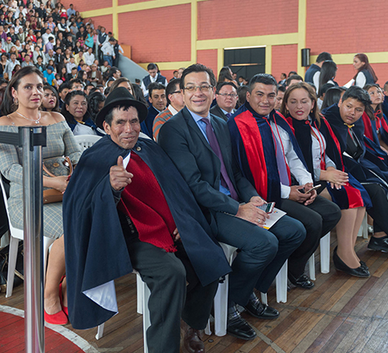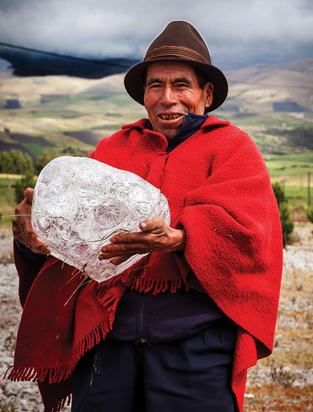Ecuador’s last ‘iceman’ continues to ply his trade on Mount Chimborazo; Learns to read
Editor’s note: Baltazar Ushca, sometimes referred to as the “iceman of Chimborazo,” was one of 27,000 adults who successfully completed the ministry of education’s Todos ABC program to learn to read and write. He was honored in Quito this week.
By Irene Caselli
At an age when many in Europe and North America are enjoying retirement, a 76-year-old man in Ecuador still spends hours trekking up a mountain in the Andes to cut away ice to sell. He is the last practitioner of a dying trade.

Baltazar Ushca, wearing the black hat, was honored this week for learning to read and write. His is 76.
It takes Baltazar Ushca five hours to walk to the ice mine on Mount Chimborazo, the highest mountain in Ecuador and the fourth highest in South America, that has fed him and his family for generations.
The path is steep, and both wind and sunshine are strong at 4,500 meters (14,700 feet).
At 76, he appears visibly tired as he picks the ice and shapes it into blocks he can transport down to Riobamba, the nearest city, by mule.
Ushca is Ecuador’s last hielero, or iceman, a craft passed on from father to son for centuries. He has made the trip at least once a week, usually on a Thursday or Friday, since he was 15. Ushca recalls a time when dozens of hieleros harvesting ice from Ecuador’s highest peaks, and when he had to compete with others on Chimborazo.
Before refrigerators, natural ice was used to refrigerate food. Nowadays, ice from Mount Chimborazo is used to make traditional fruit juices or ice creams — people claim it has natural healing properties.
All the other hieleros have passed away or found easier and better-paying jobs. But Ushca’s attachment to his trade has served him well.

Baltazar Ushca holds a chunk of ice he harvested from Mt. Chimborazo.
His reputation as the “last iceman” has brought him fame and has transformed his work into a more lucrative business. Dozens of international film crews have followed him up Mount Chimborazo and in 2012 he flew to New York City for the premiere of one of the many documentaries that have been made about him.
Locally, he is also renowned. At La Merced market where he sells the ice, people of all ages ask to have their photos taken with him. He has brushed shoulders with Ecuador Presidents Rafael Correa and Lenin Moreno and other politicians, who have hailed his work as part of the country’s cultural heritage.
Ushca dismisses the story, put out by some in his community, that he has become rich. “My family is envious that I am a friend of presidents,” he says. “I tell them, just come and do my work.”
At just 1.5 meters tall (4ft 11 inches) he can carry two 30kg (66lb) blocks of ice on his shoulders. “This is a man’s work,” he says, proudly.
He says he is happy to work on the mountain, which indigenous people regard as sacred. “I am happy when I walk. Father Chimborazo looks after me,” he says in broken Spanish. He is more at ease in Quechua, the most widely spoken indigenous language in the Andes. Only this year, he has learned to read and write in Spanish.
Ushca’s weather-beaten face reflects years of exposure to the wind and sun. He has never worn sunglasses to protect his eyes from the reflected glare of the sun on the snow. As a result, he is constantly squinting.

Ushca was the subject of a 2012 documentary movie.
Images from the 1970s show that little has changed in the ritual of collecting the ice, although demand was much higher before fridges were widely available in Ecuador. “We would go in a group of friends — four or six groups,” he says. “I would go with my mother and father, with my brothers and sisters.”
The Chimborazo glacier has receded over the past two decades, adding several hundred yards to his climb to the ice.
Nowadays, it is only Juan, his son-in-law, who keeps him company. The two leave their community of Cuatro Esquinas around 7 a.m. During the first hour, Ushca rides his donkey, while Juan walks.
On colder days, the wind and snow mean the temperature is well below zero. Sun in warmer weather increases the chances of avalanches.
At the pajonal, the area with low brushes typical of high-altitude Andean landscapes, they stop and Ushca picks up straw that he uses to wrap up the ice. He then loads the straw on his donkey, and starts walking. The last part of the path is full of loose rocks, and Ushca leads the mule carefully.
He reaches the ice mine, called Los Hieleros, around midday. It is a part of the glacier covered by rocks, connected to the main glacier, which is at least another 500m (1,640ft) up. Ushca uses a pick to break a block of ice off the glacier.
He then sculpts the block into cubes and wraps them in straw to transport them on the mule. It is 4 p.m. by the time he is back home.
On Saturday, he travels to Riobamba’s main markets to sell the ice for $4 a block.
For decades, Ushca supported his family by picking ice and growing vegetables in the fields around his modest home. “This is how we work because of poverty. I am poor and I have no other choice,” he says.
These days, there seems to be a different option for Ushca — an option of which his son-in-law, Juan, is very aware.
Juan charges foreigners $60 (£38) a day for an excursion to the ice mine. He believes he could charge more to see a real iceman in action, and he hopes he can take over his father-in-law’s job when he retires.
“Hopefully this tradition will continue,” he says.
Juan might be right. While modern technology has made some trades obsolete, turning the iceman into a tourist attraction might help this ancient tradition survive.




















